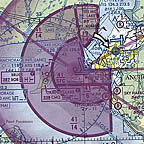
It's not essential that you understand the way airspace is carved up in order to enjoy using ATC and radio communications in Flight Simulator. In Flight Simulator, the ATC menu changes according to various factors, some having to do with what type of airspace you're in or approaching. In the real world, you're required to speak with a controller to enter certain classes of airspace. But if you don't speak to a controller in Flight Simulator, we won't take your pilot certificate away.
However, if you're interested in what various airspace classifications mean in the United States, read on.
Related
Links
|
||||||||||||
U.S. Airspace Classifications
Class A (Alfa)
Includes airspace from 18,000 feet (5,486 meters) above mean sea level (MSL) up to and including FL600 (Flight Level 600, or 60,000 feet/18,288 meters). Unless otherwise authorized, pilots must operate under instrument flight rules in Class A airspace.
Class B (Bravo)
Includes controlled airspace from the surface to 10,000 feet (3,048 meters) MSL surrounding the busiest airports. Class B airspace volumes are individually tailored, but usually include airspace within 30 miles of the primary airport. To operate in real-world Class B airspace, pilots must meet certain requirements for certification, weather conditions, and aircraft equipment, although you don't need to worry about these factors in Flight Simulator. You're required to contact and receive a clearance from ATC prior to entering Class B airspace in the real world. If you take off from within Class B or Class C airspace in Flight Simulator, ATC behaves as though Flight Following service is automatic, meaning that ATC will handle your flight until you're out of the Class B or Class C airspace.
 Airspace Classifications: A-Class Alfa, B-Class Bravo, C-Class Charlie, D-Class Delta, E-Class Echo, G-Class Golf |
Class C (Charlie)
Includes airspace from the surface to 4,000 feet (1,219 meters) MSL above an airport with an operational control tower and that is serviced by a Terminal Radar Approach Control (TRACON). Class C airspace is individually tailored for each airport, but it usually extends in a radius of five nautical miles (9.26 kilometers), rising from the surface up to 4,000 feet, and then has a shelf area extending 10 nautical miles (18.52 kilometers) from 1,200 feet (366 meters) to 4,000 feet. You're required to establish communication with ATC prior to entering Class C airspace in the real world.
Class D (Delta)
Includes airspace from the surface to 2,500 feet (762 meters) MSL above an airport with an operational control tower. Class D airspace is individually tailored for the airport it surrounds. You're required to establish communication with ATC prior to entering Class D airspace in the real world.
Class E (Echo)
All other controlled airspace that is not included in Class A, B, C, or D. You're not required to communicate with anyone when flying in Class E airspace unless the weather calls for IFR.
Class G (Golf)
Uncontrolled airspace with three different altitude levels: from the surface up to and including 1,200 feet (365.76 meters) above ground level (AGL); more than 1,200 feet AGL but less than 10,000 feet (3,048 meters) MSL; and at or above 10,000 feet MSL up to but not including 14,500 feet (4,420 meters) MSL. You're not required to communicate with anyone when flying in Class G airspace.